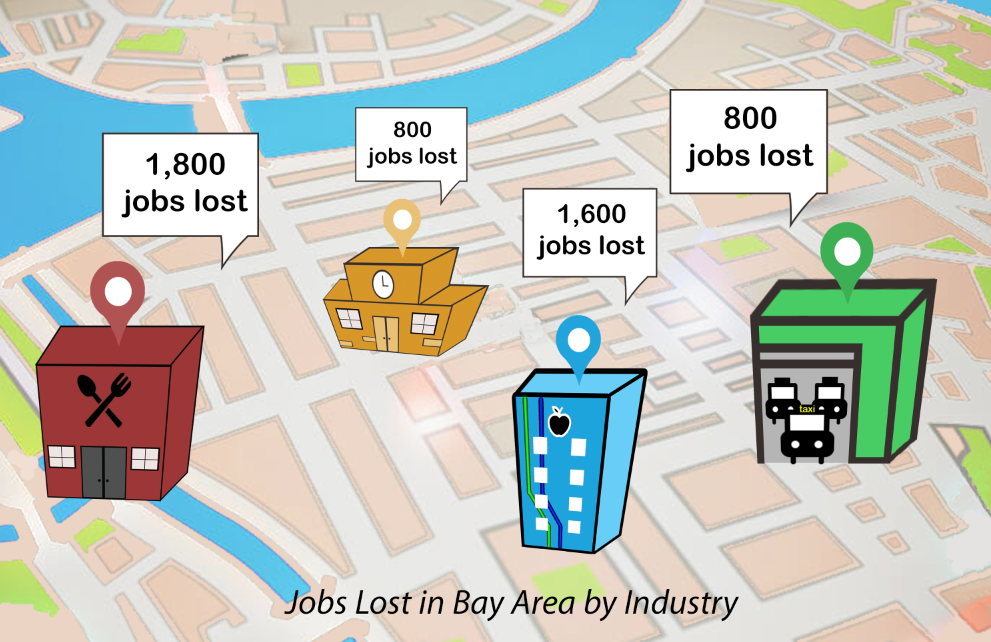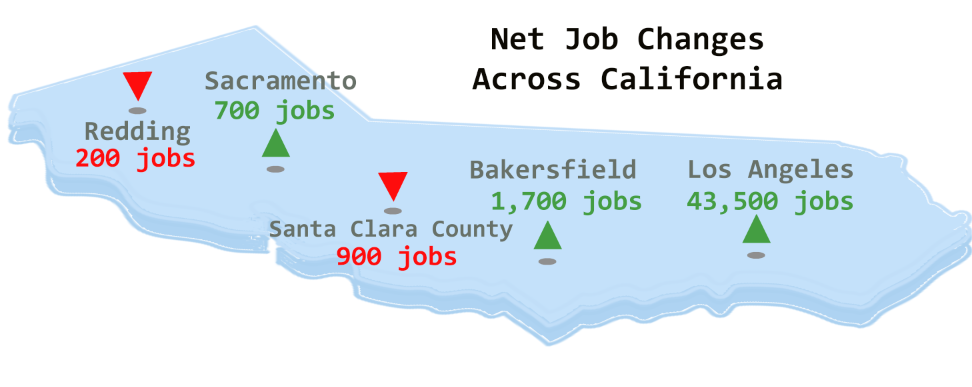Significant job losses jolt Bay Area industries
November 2, 2017
The housing crisis in the Bay Area is a prevalent local topic of concern, as buying and renting costs rise exponentially and market values increase. Nevertheless, recent job losses in the Bay Area have come as a surprise to many. In September alone, more than 4,700 individuals lost their jobs, the highest monthly statistic recorded in seven years. As a result, some view this as the start of the Bay Area economy’s transition into its previous recessional state of 20078. Others feel that it may not have an effect presently and believe that the downward trend must continue in order to foretell the final outcome.
A massive job-loss phenomenon last occurred in 2008, during the recession that caused the economy to collapse. Layoffs and downsizing were omnipresent within every sector, drastically increasing foreclosures and widening the income gap in San Francisco more than in any other U.S. city from 2007 to 2012.
For the past five years, the Bay Area increased the number of technology related jobs, but at a slower rate. Compared to those of the first few months of 2016, the rates at which jobs increased were significantly slower in the early months of 2017. Some analysts believe that the tech industry has reached its saturation point, with no more employees needed due to more efficient workspaces and artificial intelligence machines.
“I think jobs are slowly going to transition,” said senior Avinash Jain. “People are realizing that a lot of the labor-intensive jobs that usually were sought after are now being done more cheaply and more efficiently by robots and technology.”
For instance, Santa Clara County lost 7,900 jobs this September, according to the San Jose Mercury News. This is a stark contrast to its economic growth in 2016, where the county produced about 2,600 opportunities per month.
As business employment slows down, many jobs in the support and service field have been decreasing rapidly. The field encompasses healthcare, hotel and restaurant management. Its hospitality sector lost 500 jobs and administrative services lost 800 jobs. According to recent reports, the area has lost 1,800 jobs in the industry, with 1,200 jobs lost in September alone.

“When I was working for a CPA firm,” said business teacher Andrea Badger, “we had a huge layoff after my first year because they had hired too many people at my level, because they were predicting that businesses in the year 2000, things were booming and then it went somewhat stagnant, and they hired based on continual growth. And so there wasn’t as much demand. So a lot of my friends got laid off.”
Due to the local economy’s focus on promoting high paying jobs in the tech and financial industries, there is an underlying hostility toward middle-class families and various industries are moving toward other areas in the country where it is remarkably easier to lead an affluent lifestyle. As the cost of living in the Bay Area increases, workers in the service sector face financial challenges as they struggle to afford necessities such as rent, food and health care caused by skyrocketing real estate prices. This leads to an inability to live near their workplaces and thus causes longer commutes in the morning. This trend is exemplified through the relocation of many service jobs originally in the Bay Area to Las Vegas.
“Many people in this area don’t have a lot of savings because it is so expensive to live here,” said Badger. “Where job loss cannot be too bad because they have time to find a job, I’m worried that that time here is very short.”
Without a stable service sector, the dependent technology and automobile industries will decline. While this is not an issue yet, it is currently a growing concern. Within the automobile industry, Chevron axed 500 jobs in the Bay Area alone in the summer of 2015, struggling to maintain its spot as the Bay Area’s 20th largest employer.
“For a community full of engineers to exist, there has to be a stable base of service sector jobs. If there is no service sector, then this society will tumble down.”
Jeffrey Bale, U.S. Gov. and Econ. teacher.
In recent years, companies who focus on technological advancements and engineering have shut down large branches or announced layoffs, impacting the entire Bay Area. Oracle, a globally recognized software company, has announced approximately 2,500 job cuts. Additionally, Hewlett-Packard, a leader in computer manufacturing, is planning to axe about 10 percent of its staff, despite market shares going up to 2.5 percent in the past year. The layoffs are expected since the company split in two in 2014, which reduced sales of their products dramatically. Additionally, SoundCloud unexpectedly announced that they were to going layoff 40 percent of their staff in 2017 thinking that they would have to shut down after losing $52 million in 2015 from the failure of their paid subscription program.
“One reason for job cuts is if the company isn’t being profitable,” said Badger. “They’re trying to consolidate jobs. They take two jobs and merge them into one. They’re finding ways to be more financially efficient.”
Another unstable industry is construction, which has been completely dependent on the amount of land available for development. As the Bay Area’s economy grows at a steady 0.7 percent annually, the space to expand decreases, with the only direction of expansion available being upward. Tall skyscrapers and apartment style residential buildings are dominating as the construction sector’s biggest projects. Constructing tall structures, however, is geologically inimical due to the Bay Area’s frequent low-magnitude earthquakes. As new development decreases, the housing market bubble is expected to pop, hitting its potential peak and widening the income gap.
The preferred solutions to this widening gap consist of increasing salaries and employee benefits, such as more sick days or better insurance coverage. While these are certainly advantages for workers, they can cause companies and small businesses within the service industry to become less profitable, and thus increase the number of layoffs. The other plausible option is reducing housing costs, which is highly unlikely due to the rarity of property and the rising market prices.
Among these concerns, however, rests the opinion that these statistics have yet to gain their significance as time goes on.
“Why one month isn’t significant is because that could be the closing of one business,” said Badger. “Usually a one month thing is something to keep an eye on, but usually there’s no direct impact of a one month decrease.”
Despite the apparent issues within the local economy, the East Bay is a proof of hope, as it continues to add jobs in all fields, with the healthcare industry adding 2,400 jobs, the most in the area. Furthermore, the Santa Clara Valley recently created 600 jobs in the tech industry, and San Francisco added 1,600 jobs to the construction sector.
“If you look at the numbers, it could be that some of those are just normal fluctuations of when they’re announcing things.” said Bale, “You could have this tremendous boost in hiring in any given month.”
The boom-and-bust economy in the Bay Area has led to huge layoffs within local companies. Nevertheless, the population growth means that human capital is nowhere near a shortage, and the area is as vibrant as ever. The unique atmosphere in the Bay Area marked by innovation and growth does not seem to be dying, only declining temporarily. The technological sector continues to be the highest employing industry within the Bay Area, demonstrating that the omnipresent entrepreneurial engineers and the quick-paced environment that they work in will not be shutting down any time soon.




































































